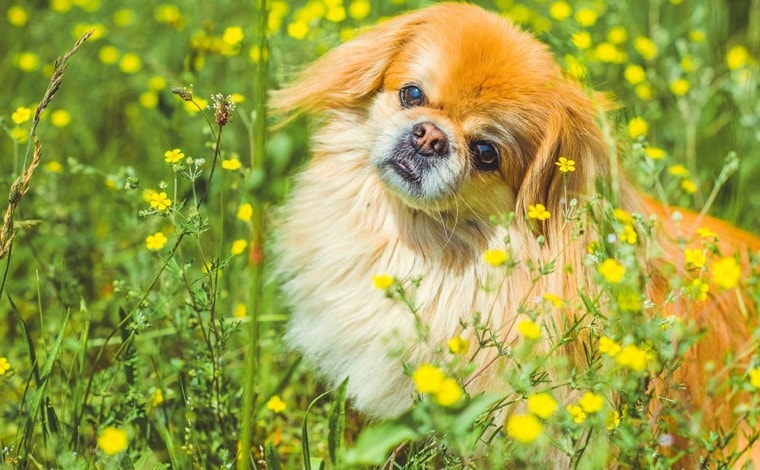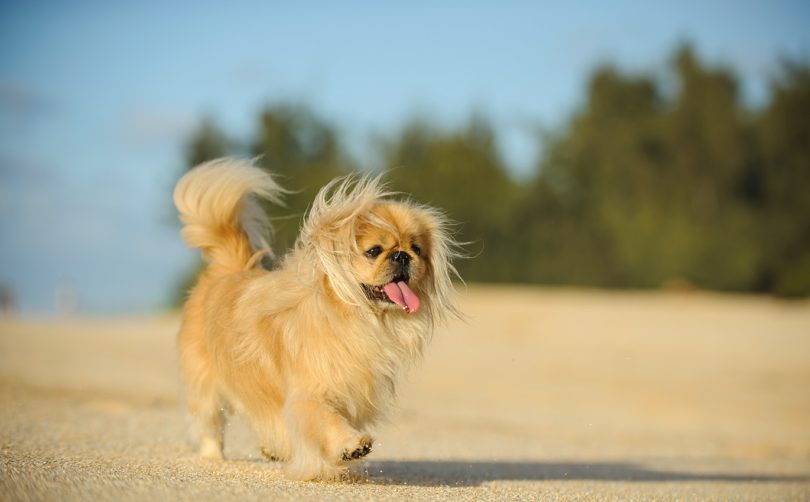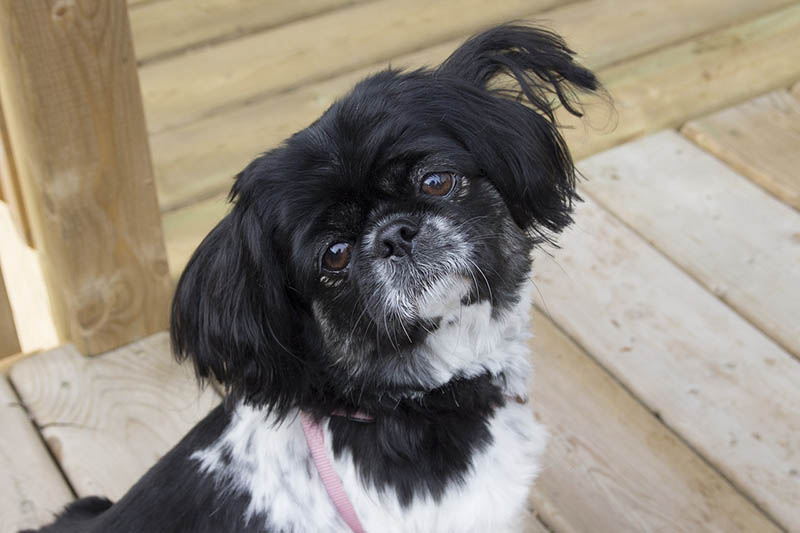
Click Below to Skip Ahead
The Pekingese dog breed, also known as the Lion Dog or Peke, is notable for its small size, laid-back demeanor, and perky little face. Prominent in Chinese history as the chosen companion of royalty, these dogs are one of the oldest breeds around. In fact, during the reign of the T’ang Dynasty, they were the only toy breed! Stealing one would amount to a death penalty.
This breed was the chosen companion at the Chinese imperial court as early as the Han Dynasty (206 BCE-220CE). During the time, China had become a Buddhist country, and the rulers wanted to replicate the taming of lions similar to India. However, there were no lions in China, and the monks turned to dogs with similar looks.
Breed Overview
Height:
6 – 9 inches
Weight:
7 – 14 lb.
Lifespan:
12 – 15 years
Colors:
Light red, red brindle, black, black and tan, cream, fawn, fawn sable, gray sable, red, red sable, white, fawn brindle
Suitable for:
Seniors, families with grown children, those looking for a loyal companion
Temperament:
Loyal, Loving, Affectionate, Intelligent, Stubborn, Headstrong
Since the Chinese only had carvings for lions, they began to breed the dogs to become closer to the lion. Although the Pekingese are small, they resembled the re-imagined creature rather than the actual wild cats.
These little furry friends have an ego bigger than their bodies. Despite that, they are generally affable and affectionate. Here’s where it gets interesting. They seem to know of their royal ancestry with their aloof and snobby personality.
So, what does it take to be the owner of one of these regal pups? Let’s find out!
The Pekingese Puppies

Once you decide to buy one of these puppies, it is advisable to learn a few things to be ready for any eventuality. For instance, learn about their lifespan, trainability, and sociability. This way you will know what to expect along the way.
Having a dog takes a lot of responsibility and this is no exception for taking care of Pekingese dogs. They require exercise, mental stimulation, grooming, and lots of love. They’re loyal dogs that will create strong bonds with their owners and will enjoy lots of playtime. Below is the full care guide for the Pekingese so you know how to care for them from when they’re puppies to when they grow into adults.
Temperament & Intelligence of the Pekingese
Pekingese dogs are some of the most intelligent dogs around! They are easy to train and quite friendly. Many tend to be aloof around strangers but fun, funny, and full of life around the owner.
They are a little selective on who to lavish their affection. That is not strange for a loyal dog that only wants to make the owner feel special. It also makes them excellent guard dogs. Some may bark too much at strangers, so it’s up to you to train them when to stop. Their bravery sometimes gets to be foolhardy.
That means they are not timid lapdogs. Although the little canines will not start a fight, they will not back down if they need to defend themselves. They are also very alert and can sense danger very fast and sound the alarm.
The Pekingese dog breed is at its happiest around the owner. They are confident, but not overly so. They have a laid-back, relaxed air about them that is very inviting.
Their intelligent minds and independent mind renders them stubborn and can be argumentative. They will never be as obedient as a Labrador, but they can learn tricks and such if you are patient enough! In fact, their stubbornness is legendary.
Keep in mind that they do not respond well to harsh discipline and training. The dogs can become defensive very fast and possibly bite the owner.

Are These Dogs Good for Families? 👪
While many dog breeds are perfect for homes with larger families, the Pekingese dogs are a bit different. They are practical for families with older children since they do not like getting manhandled and are prone to get hurt easily. They are stubborn, and hence, may not be the best choice for a first-time dog owner.
On the good side, they are playful around family members, but they are not what children would like. If you want to own one, ensure you supervise any interactions with children.
Does This Breed Get Along with Other Pets?
Pekingese dogs tend to get aggressive with other animals. For instance, they prefer the company of other dogs of their kind. They take a long time to get accustomed to other breeds and pets.
They have a tendency to bark and chase smaller pets like cats and even bigger dogs. Sometimes the other animal may be too big for the small canines and only end up with injuries. Their protuberant eyes could easily get poked or scratched with a single swipe of claws or paws.
However, they can live with another dog in the house with proper socialization. Pekingese dogs are a breed that is sensitive to other animals, so they need adequate socialization from a young age. Early exposure to different people, animals, experiences, sounds, and sights can make them a little more tolerant.
With proper training, they learn to live in harmony with other pets such as cats and other dogs and include them in their royal group. With that in mind, until you are sure all is well with the resident pet, supervise all active plays.
Things to Know When Owning a Pekingese
Food & Diet Requirements 🦴
Owning a Pekingese breed can be a little complicated. These tiny dogs require a lot of grooming and maintenance, especially when they are puppies. To begin with, they need a balanced diet and in small portions.
The Pekingese dog breed has a small stomach capacity and hence the need for small servings. They may look as if they want more, but it will only make them sick.
While this breed of dogs isn’t delicate or dainty, they are nonetheless prone to gastrointestinal upset. Also, they are prone to obesity. That’s because they are not that active in nature.
Like most animals, obesity can cause problems later in life. They may suffer from back problems due to improper weight control. That can be prevented by keeping accurate records of food intake.
First on their diet is proteins. Whether feeding homemade or commercial pet food, meat is a must. Ensure Pekingese dog food has between 50-80% animal proteins.
It could be from fish, lamb, poultry, pork, and a small number of eggs. It is also crucial to remember that dogs have tiny teeth and cannot chew large pieces of meat. It should be grounded into a fine paste or cut into small units before serving the dogs.
To get vitamins, the Pekingese Dogs can feed on such foods as broccoli, squash, and asparagus. They can also eat other cooked veggies. However, like other animals or people, it boils down to preferences.
When feeding your dog, ensure the food contains about 25% vegetables or fruits. For minerals, they need things like carrots and sweet potatoes. Insist on certified commercial foods for Pekingese dogs to avoid things that may upset their delicate system.
Starch and fat are also critical alongside other diets. Your Pekingese dogs can have foods like potatoes, oatmeal, and rice. That should comprise about 10% of the diet.
Avoid hard food like corn and other things that your dog can’t digest.
For a sensitive tummy like that of your Pekingese dog, fats are critical. For that reason, add about 15% of oils such as wild salmon oil.

Exercise 🐕
Unlike other bigger dogs, the Pekingese breed requires minimum exercise. They are pretty inactive puppies and adults, so owners should take that into account when exercising them.
That does not mean they never need any exercise. These dogs are pretty playful, so they need some time to run around and play with toys. The best idea is to go for walks and play with them for a minimum of 30-minutes.
It would be enough to keep them healthy and active. However, don’t overdo it as it could cause breathing problems due to their flatter noses.
They are also sensitive to heat, so exercise them in cool temperatures and avoid direct sunlight. That’s because of their thick fur. The ideal time would be early morning or late evening.
Training 🎾
As mentioned earlier, the Pekingese dogs tend to be very stubborn. To get them to follow your instructions, you will need a lot of patience and effort. It would take around 6-12 months for your dog to start responding to protocol.
If not trained properly, the little canine can develop a small dog syndrome. It needs to maintain an alpha dog status to be manageable and behave well.
Failure to do this, the dog will develop negative behaviors like obstinate, separation anxiety, and jealousy. They may also develop unprovoked or excessive growling, over guarding, snapping, or even biting.
Grooming ✂️
These little dogs require a lot of grooming. They have long, thick coats that need to get brushed every other day, twice a day if possible. If they do not, you will notice an increase in hair fall and matting of the fur.
Apart from brushing, your Pekingese dogs will need baths to keep them looking their best. If you are not too sure about fur brushing, ask the breeder for specific instructions. If it is your first time with a Pekingese, try to introduce your dog slowly.
Most people who choose Pekingese dogs as companions prefer coat trimming. When the fur is short, it eases the burden of daily grooming.
In addition to hair, their eyes should be cleaned every day. They also tend to have a lot of ear wax build-up. The best idea is to use vet-recommended ear drops for dogs to avoid infections.
Additionally, wash your dog’s ears and face. Use a wet cloth or cotton ball and pay close attention to the eyes and wrinkles. This way, you get rid of excess skin oils and prevent tear stains.
Nails need trimming frequently. Long nails can be uncomfortable for your dog. Although they are not too difficult to clip, they can cause pain or bleeding if done incorrectly.
For that reason, call an expert or your vet for help if this is the first time doing it. A groomer can teach you how to do it properly.

Health and Conditions 🏥
Pekingese adult dogs are generally healthy. However, you will need to take care of them properly. If not, they can develop many health problems.
Like people, purebred Pekingese dogs have the probability of being affected by genetic health problems. Your breeder should offer a health guarantee on all puppies.
Male vs. Female
Male Pekinese are generally larger than females and consequently, they eat more.
The size comes with more weight and strength. The size difference is usually a few inches, but the weight can be substantial. The only instance when female Pekingese dogs will weigh more and eat more is when pregnant.
Male Pekingese dogs are also more independent and aggressive than their female counterparts. They are harder to manage in confined areas and most times don’t socialize well with other males. The situation can be even more difficult if there are female dogs in the area.
On the other hand, female Pekingese dogs can be overly aggressive, particularly when protecting puppies. Additionally, they come into heat at least twice a year and can produce multiple litters of puppies. To prevent mating of either sex, spay or neuter your dogs.
Three Little-Known Facts About the Pekingese
You may assume you know everything about your Pekingese, but there are little-known facts that might surprise you.
Here are three facts about Pekingese dogs:
1. They Are Double-Coated
These tiny pups are double-coated. They have both an undercoat and a top coat of hair that help insulate them. The undercoat is thick and soft, while the exterior one is straight and long. The extra protection also helps repel water.
2. They Are At Least 2,000 Years Old
Pekingese dogs are no newbies to the world stage. In fact, DNA shows that they are at least 2000 years old. They have been so popular because they are loyal, affectionate, and easy to train. They were even used as guard dogs by some Chinese emperors.
3. They First Came to England during the Opium War
Now get this- the Pekingese dog breed was introduced to the West during the Opium War, back in 1860-1862. From there, they became a status symbol, and in the 1880s, Queen Victoria received eight of them as gifts.
There you have it. Three unknown facts about the Pekingese. As you can see, they are a special breed with a long history.
Final Thoughts
The Pekingese dog breed can be a great companion for any active, single, or family person. They are very affectionate, loyal, and lovely.
However, before committing to adopt one, you need to know that they will depend on you for grooming, food, and affection. Like most pets, owning a Pekingese dog is not just a privilege but also a responsibility. If you are not willing to commit to that, you shouldn’t keep one.
If you have a home and enough time, a Pekingese dog could be the perfect pet for you and your family. Remember, male Pekingese are easier to find compared to females.
See Also:
Featured Image Credit: T.Den_Team, Shutterstock








